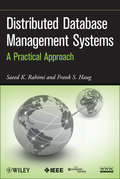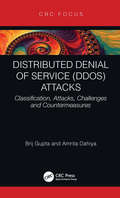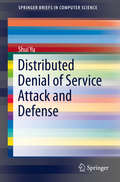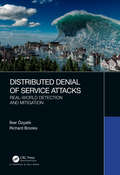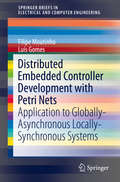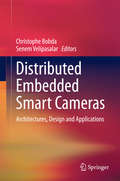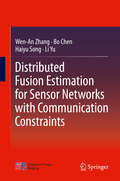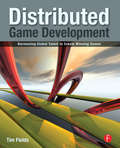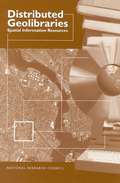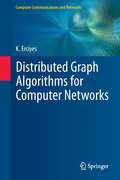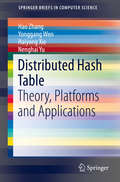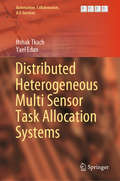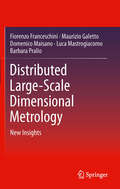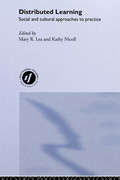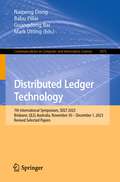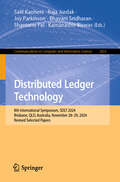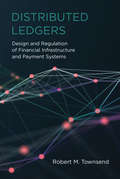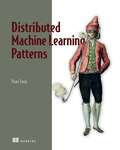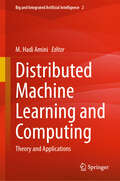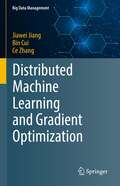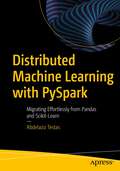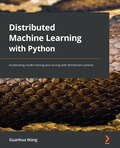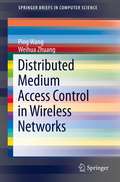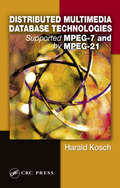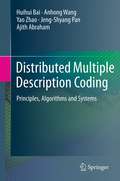- Table View
- List View
Distributed Database Management Systems: A Practical Approach
by Saeed K. Rahimi Frank S. HaugThis book addresses issues related to managing data across a distributed database system. It is unique because it covers traditional database theory and current research, explaining the difficulties in providing a unified user interface and global data dictionary. The book gives implementers guidance on hiding discrepancies across systems and creating the illusion of a single repository for users. It also includes three sample frameworks—implemented using J2SE with JMS, J2EE, and Microsoft .Net—that readers can use to learn how to implement a distributed database management system. IT and development groups and computer sciences/software engineering graduates will find this guide invaluable.
Distributed Denial of Service (DDoS) Attacks: Classification, Attacks, Challenges and Countermeasures
by Brij B. Gupta Amrita DahiyaThe complexity and severity of the Distributed Denial of Service (DDoS) attacks are increasing day-by-day. The Internet has a highly inconsistent structure in terms of resource distribution. Numerous technical solutions are available, but those involving economic aspects have not been given much consideration. The book, DDoS Attacks – Classification, Attacks, Challenges, and Countermeasures, provides an overview of both types of defensive solutions proposed so far, exploring different dimensions that would mitigate the DDoS effectively and show the implications associated with them. Features: Covers topics that describe taxonomies of the DDoS attacks in detail, recent trends and classification of defensive mechanisms on the basis of deployment location, the types of defensive action, and the solutions offering economic incentives. Introduces chapters discussing the various types of DDoS attack associated with different layers of security, an attacker’s motivations, and the importance of incentives and liabilities in any defensive solution. Illustrates the role of fair resource-allocation schemes, separate payment mechanisms for attackers and legitimate users, negotiation models on cost and types of resources, and risk assessments and transfer mechanisms. DDoS Attacks – Classification, Attacks, Challenges, and Countermeasures is designed for the readers who have an interest in the cybersecurity domain, including students and researchers who are exploring different dimensions associated with the DDoS attack, developers and security professionals who are focusing on developing defensive schemes and applications for detecting or mitigating the DDoS attacks, and faculty members across different universities.
Distributed Denial of Service Attack and Defense
by Shui YuThis brief provides readers a complete and self-contained resource for information about DDoS attacks and how to defend against them. It presents the latest developments in this increasingly crucial field along with background context and survey material. The book also supplies an overview of DDoS attack issues, DDoS attack detection methods, DDoS attack source traceback, and details on how hackers organize DDoS attacks. The author concludes with future directions of the field, including the impact of DDoS attacks on cloud computing and cloud technology. The concise yet comprehensive nature of this brief makes it an ideal reference for researchers and professionals studying DDoS attacks. It is also a useful resource for graduate students interested in cyberterrorism and networking.
Distributed Denial of Service Attacks: Real-world Detection and Mitigation
by Richard Brooks İlker ÖzçelikDistributed Denial of Service (DDoS) attacks have become more destructive, wide-spread and harder to control over time. This book allows students to understand how these attacks are constructed, the security flaws they leverage, why they are effective, how they can be detected, and how they can be mitigated. Students use software defined networking (SDN) technology to created and execute controlled DDoS experiments. They learn how to deploy networks, analyze network performance, and create resilient systems. This book is used for graduate level computer engineering instruction at Clemson University. It augments the traditional graduate computing curricula by integrating: Internet deployment, network security, ethics, contemporary social issues, and engineering principles into a laboratory based course of instruction. Unique features of this book include: A history of DDoS attacks that includes attacker motivations Discussion of cyber-war, censorship, and Internet black-outs SDN based DDoS laboratory assignments Up-to-date review of current DDoS attack techniques and tools Review of the current laws that globally relate to DDoS Abuse of DNS, NTP, BGP and other parts of the global Internet infrastructure to attack networks Mathematics of Internet traffic measurement Game theory for DDoS resilience Construction of content distribution systems that absorb DDoS attacks This book assumes familiarity with computing, Internet design, appropriate background in mathematics, and some programming skills. It provides analysis and reference material for networking engineers and researchers. By increasing student knowledge in security, and networking; it adds breadth and depth to advanced computing curricula.
Distributed Embedded Controller Development with Petri Nets
by Filipe Moutinho Luís GomesThis book describes a model-based development approach for globally-asynchronous locally-synchronous distributed embedded controllers. This approach uses Petri nets as modeling formalism to create platform and network independent models supporting the use of design automation tools. To support this development approach, the Petri nets class in use is extended with time-domains and asynchronous-channels. The authors' approach uses models not only providing a better understanding of the distributed controller and improving the communication among the stakeholders, but also to be ready to support the entire lifecycle, including the simulation, the verification (using model-checking tools), the implementation (relying on automatic code generators), and the deployment of the distributed controller into specific platforms. Uses a graphical and intuitive modeling formalism supported by design automation tools; Enables verification, ensuring that the distributed controller was correctly specified; Provides flexibility in the implementation and maintenance phases to achieve desired constraints (high performance, low power consumption, reduced costs), enabling porting to different platforms using different communication nodes, without changing the underlying behavioral model.
Distributed Embedded Smart Cameras
by Christophe Bobda Senem VelipasalarThis publication addresses distributed embedded smart cameras -cameras that perform on board analysis and collaborate with other cameras. This book provides the material required to better understand the architectural design challenges of embedded smart camera systems, the hardware/software ecosystem, the design approach for and applications of distributed smart cameras together with the state-of-the-art algorithms. The authors concentrate on the architecture, hardware/software design, realization of smart camera networks from applications to architectures, in particular in the embedded and mobile domains.
Distributed Fusion Estimation for Sensor Networks with Communication Constraints
by Wen-An Zhang Bo Chen Haiyu Song Li YuThisbook systematically presents energy-efficient robust fusion estimation methodsto achieve thorough and comprehensive results in the context of network-basedfusion estimation. It summarizes recent findings on fusion estimation withcommunication constraints; several novel energy-efficient and robust designmethods for dealing with energy constraints and network-induced uncertaintiesare presented, such as delays, packet losses, and asynchronous information. . . All the results are presented as algorithms, which are convenient for practicalapplications.
Distributed Game Development: Harnessing Global Talent to Create Winning Games
by Tim FieldsTake control of your global game development team and make successful AAA game titles using the 'Distributed Development' model. Game industry veteran Tim Fields teaches you how to evaluate game deals, how to staff teams for highly distributed game development, and how to maintain challenging relationships in order to get great games to market. This book is filled with interviews with a broad spectrum of industry experts from top game publishers and business owners in the US and UK. A supplementary web site provides interviews from the book, a forum where developers and publishers can connect, and additional tips and tricks. Topics include:
Distributed Geolibraries: Spatial Information Resources Summary of a Workshop
by National Research CouncilPresents the findings of the Workshop on Distributed Geolibraries: Spatial Information Resources, convened by the Mapping Science Committee of the National Research Council in June 1998
Distributed Graph Algorithms for Computer Networks
by K. ErciyesThis book presents a comprehensive review of key distributed graph algorithms for computer network applications, with a particular emphasis on practical implementation. Topics and features: introduces a range of fundamental graph algorithms, covering spanning trees, graph traversal algorithms, routing algorithms, and self-stabilization; reviews graph-theoretical distributed approximation algorithms with applications in ad hoc wireless networks; describes in detail the implementation of each algorithm, with extensive use of supporting examples, and discusses their concrete network applications; examines key graph-theoretical algorithm concepts, such as dominating sets, and parameters for mobility and energy levels of nodes in wireless ad hoc networks, and provides a contemporary survey of each topic; presents a simple simulator, developed to run distributed algorithms; provides practical exercises at the end of each chapter.
Distributed Hash Table
by Hao Zhang Yonggang Wen Haiyong Xie Nenghai YuThis SpringerBrief summarizes the development of Distributed Hash Table in both academic and industrial fields. It covers the main theory, platforms and applications of this key part in distributed systems and applications, especially in large-scale distributed environments. The authors teach the principles of several popular DHT platforms that can solve practical problems such as load balance, multiple replicas, consistency and latency. They also propose DHT-based applications including multicast, anycast, distributed file systems, search, storage, content delivery network, file sharing and communication. These platforms and applications are used in both academic and commercials fields, making Distributed Hash Table a valuable resource for researchers and industry professionals.
Distributed Heterogeneous Multi Sensor Task Allocation Systems (Automation, Collaboration, & E-Services #7)
by Itshak Tkach Yael EdanToday’s real-world problems and applications in sensory systems and target detection require efficient, comprehensive and fault-tolerant multi-sensor allocation. This book presents the theory and applications of novel methods developed for such sophisticated systems. It discusses the advances in multi-agent systems and AI along with collaborative control theory and tools. Further, it examines the formulation and development of an allocation framework for heterogeneous multi-sensor systems for various real-world problems that require sensors with different performances to allocate multiple tasks, with unknown a priori priorities that arrive at unknown locations at unknown time. It demonstrates how to decide which sensor to allocate to which tasks when and where. Lastly, it explains the reliability and availability issues of task allocation systems, and includes methods for their optimization.The presented methods are explained, measured, and evaluated by extensive simulations, and the results of these simulations are presented in this book. This book is an ideal resource for academics, researchers and graduate students as well as engineers and professionals and is relevant for various applications such as sensor network design, multi-agent systems, task allocation, target detection, and team formation.
Distributed Large-Scale Dimensional Metrology
by Domenico Maisano Fiorenzo Franceschini Luca Mastrogiacomo Barbara Pralio Maurizio GalettoThe field of large-scale dimensional metrology (LSM) deals with objects that have linear dimensions ranging from tens to hundreds of meters. It has recently attracted a great deal of interest in many areas of production, including the automotive, railway, and shipbuilding sectors. Distributed Large-Scale Dimensional Metrology introduces a new paradigm in this field that reverses the classical metrological approach: measuring systems that are portable and can be easily moved around the location of the measured object, which is preferable to moving the object itself. Distributed Large-Scale Dimensional Metrology combines the concepts of distributed systems and large scale metrology at the application level. It focuses on the latest insights and challenges of this new generation of systems from the perspective of the designers and developers. The main topics are: coverage of measuring area,sensors calibration,on-line diagnostics,probe management, andanalysis of metrological performance.The general descriptions of each topic are further enriched by specific examples concerning the use of commercially available systems or the development of new prototypes. This will be particularly useful for professional practitioners such as quality engineers, manufacturing and development engineers, and procurement specialists, but Distributed Large-Scale Dimensional Metrology also has a wealth of information for interested academics.
Distributed Learning: Social and Cultural Approaches to Practice
by Mary R. Lea Kathy NicollAt a time of increasing globalisation, the concept of open and distance learning is being constantly redefined. New technologies have opened up new ways of understanding and participating in Learning. Distributed Learning offers a collection of perspectives from a social and cultural practice-based viewpoint, with contributions from leading international authors in the field. Key issues in this comprehensive text are:*the challenges of ICT to traditional teaching and learning practices*the value and relevance of 'activity theory' and 'communities of practice' in educational institutions and the workplace*perspectives on the relationship between globalisation and distributed learning, and the breakdown of distinctions between global and local contexts*issues of identity and community in designing courses for the virtual student*language and literacies in distributed learning contextsThis book provides useful introductory reading, building a sound theoretical framework for practitioners interested in how distributed learning is shaping post-compulsory education.
Distributed Ledger Technology: 7th International Symposium, SDLT 2023, Brisbane, QLD, Australia, November 30 – December 1, 2023, Revised Selected Papers (Communications in Computer and Information Science #1975)
by Mark Utting Guangdong Bai Naipeng Dong Babu PillaiThis book constitutes the proceedings of the 7th International Symposium, SDLT 2023, held in Brisbane, QLD, Australia, during November 30 – December 1, 2023.The 8 full papers and the short paper included in this volume were carefully reviewed and selected from 32 submissions. The volume focuses on current systems and new solutions to create a scientific background for a solid development of innovative Distributed Ledger Technology application.
Distributed Ledger Technology: 8th International Symposium, SDLT 2024, Brisbane, QLD, Australia, November 28–29, 2024, Revised Selected Papers (Communications in Computer and Information Science #2453)
by Salil Kanhere Raja Jurdak Shantanu Pal Joy Parkinson Bhavani Sridharan Kamanashis BiswasThis book constitutes the refereed proceedings of the 8th International Symposium on Distributed Ledger Technology, SDLT 2024, held in Brisbane, QLD, Australia, during November 28–29, 2024. The 8 full papers and 1 short paper included in this book were carefully reviewed and selected from 31 submissions. They deal with current systems and innovative solutions providing a robust scientific foundation for the advancement of Distributed Ledger Technology applications.
Distributed Ledgers: Design and Regulation of Financial Infrastructure and Payment Systems
by Robert M. TownsendAn economic analysis of what distributed ledgers can do, examining key components and discussing applications in both developed and emerging market economies.Distributed ledger technology (DLT) has the potential to transform economic organization and financial structure. In this book, Robert Townsend steps back from the hype and controversy surrounding DLT (and the related, but not synonymous, innovations of blockchain and Bitcoin) to offer an economic analysis of what distributed ledgers can do. Townsend examines the key components of distributed ledgers, discussing, evaluating, and illustrating each in the context of historical and contemporary economics, and reviewing featured applications in both developed economies and emerging-market countries.
Distributed Machine Learning Patterns
by Yuan TangPractical patterns for scaling machine learning from your laptop to a distributed cluster.Distributing machine learning systems allow developers to handle extremely large datasets across multiple clusters, take advantage of automation tools, and benefit from hardware accelerations. This book reveals best practice techniques and insider tips for tackling the challenges of scaling machine learning systems. In Distributed Machine Learning Patterns you will learn how to: Apply distributed systems patterns to build scalable and reliable machine learning projects Build ML pipelines with data ingestion, distributed training, model serving, and more Automate ML tasks with Kubernetes, TensorFlow, Kubeflow, and Argo Workflows Make trade-offs between different patterns and approaches Manage and monitor machine learning workloads at scale Inside Distributed Machine Learning Patterns you&’ll learn to apply established distributed systems patterns to machine learning projects—plus explore cutting-edge new patterns created specifically for machine learning. Firmly rooted in the real world, this book demonstrates how to apply patterns using examples based in TensorFlow, Kubernetes, Kubeflow, and Argo Workflows. Hands-on projects and clear, practical DevOps techniques let you easily launch, manage, and monitor cloud-native distributed machine learning pipelines. About the technology Deploying a machine learning application on a modern distributed system puts the spotlight on reliability, performance, security, and other operational concerns. In this in-depth guide, Yuan Tang, project lead of Argo and Kubeflow, shares patterns, examples, and hard-won insights on taking an ML model from a single device to a distributed cluster. About the book Distributed Machine Learning Patterns provides dozens of techniques for designing and deploying distributed machine learning systems. In it, you&’ll learn patterns for distributed model training, managing unexpected failures, and dynamic model serving. You&’ll appreciate the practical examples that accompany each pattern along with a full-scale project that implements distributed model training and inference with autoscaling on Kubernetes. What's inside Data ingestion, distributed training, model serving, and more Automating Kubernetes and TensorFlow with Kubeflow and Argo Workflows Manage and monitor workloads at scale About the reader For data analysts and engineers familiar with the basics of machine learning, Bash, Python, and Docker. About the author Yuan Tang is a project lead of Argo and Kubeflow, maintainer of TensorFlow and XGBoost, and author of numerous open source projects. Table of Contents PART 1 BASIC CONCEPTS AND BACKGROUND 1 Introduction to distributed machine learning systems PART 2 PATTERNS OF DISTRIBUTED MACHINE LEARNING SYSTEMS 2 Data ingestion patterns 3 Distributed training patterns 4 Model serving patterns 5 Workflow patterns 6 Operation patterns PART 3 BUILDING A DISTRIBUTED MACHINE LEARNING WORKFLOW 7 Project overview and system architecture 8 Overview of relevant technologies 9 A complete implementation
Distributed Machine Learning and Computing: Theory and Applications (Big and Integrated Artificial Intelligence #2)
by M. Hadi AminiThis book focuses on a wide range of distributed machine learning and computing algorithms and their applications in healthcare and engineering systems. The contributors explore how these techniques can be applied to different real-world problems. It is suitable for students and researchers interested in conducting research in multidisciplinary areas that rely on distributed machine learning and computing techniques.
Distributed Machine Learning and Gradient Optimization (Big Data Management)
by Bin Cui Ce Zhang Jiawei JiangThis book presents the state of the art in distributed machine learning algorithms that are based on gradient optimization methods. In the big data era, large-scale datasets pose enormous challenges for the existing machine learning systems. As such, implementing machine learning algorithms in a distributed environment has become a key technology, and recent research has shown gradient-based iterative optimization to be an effective solution. Focusing on methods that can speed up large-scale gradient optimization through both algorithm optimizations and careful system implementations, the book introduces three essential techniques in designing a gradient optimization algorithm to train a distributed machine learning model: parallel strategy, data compression and synchronization protocol. Written in a tutorial style, it covers a range of topics, from fundamental knowledge to a number of carefully designed algorithms and systems of distributed machine learning. It will appeal to a broad audience in the field of machine learning, artificial intelligence, big data and database management.
Distributed Machine Learning with PySpark: Migrating Effortlessly from Pandas and Scikit-Learn
by Abdelaziz TestasMigrate from pandas and scikit-learn to PySpark to handle vast amounts of data and achieve faster data processing time. This book will show you how to make this transition by adapting your skills and leveraging the similarities in syntax, functionality, and interoperability between these tools. Distributed Machine Learning with PySpark offers a roadmap to data scientists considering transitioning from small data libraries (pandas/scikit-learn) to big data processing and machine learning with PySpark. You will learn to translate Python code from pandas/scikit-learn to PySpark to preprocess large volumes of data and build, train, test, and evaluate popular machine learning algorithms such as linear and logistic regression, decision trees, random forests, support vector machines, Naïve Bayes, and neural networks. After completing this book, you will understand the foundational concepts of data preparation and machine learning and will have the skills necessary to apply these methods using PySpark, the industry standard for building scalable ML data pipelines. What You Will Learn Master the fundamentals of supervised learning, unsupervised learning, NLP, and recommender systemsUnderstand the differences between PySpark, scikit-learn, and pandasPerform linear regression, logistic regression, and decision tree regression with pandas, scikit-learn, and PySparkDistinguish between the pipelines of PySpark and scikit-learn Who This Book Is For Data scientists, data engineers, and machine learning practitioners who have some familiarity with Python, but who are new to distributed machine learning and the PySpark framework.
Distributed Machine Learning with Python: Accelerating model training and serving with distributed systems
by Guanhua WangBuild and deploy an efficient data processing pipeline for machine learning model training in an elastic, in-parallel model training or multi-tenant cluster and cloudKey FeaturesAccelerate model training and interference with order-of-magnitude time reductionLearn state-of-the-art parallel schemes for both model training and servingA detailed study of bottlenecks at distributed model training and serving stagesBook DescriptionReducing time cost in machine learning leads to a shorter waiting time for model training and a faster model updating cycle. Distributed machine learning enables machine learning practitioners to shorten model training and inference time by orders of magnitude. With the help of this practical guide, you'll be able to put your Python development knowledge to work to get up and running with the implementation of distributed machine learning, including multi-node machine learning systems, in no time. You'll begin by exploring how distributed systems work in the machine learning area and how distributed machine learning is applied to state-of-the-art deep learning models. As you advance, you'll see how to use distributed systems to enhance machine learning model training and serving speed. You'll also get to grips with applying data parallel and model parallel approaches before optimizing the in-parallel model training and serving pipeline in local clusters or cloud environments. By the end of this book, you'll have gained the knowledge and skills needed to build and deploy an efficient data processing pipeline for machine learning model training and inference in a distributed manner.What you will learnDeploy distributed model training and serving pipelinesGet to grips with the advanced features in TensorFlow and PyTorchMitigate system bottlenecks during in-parallel model training and servingDiscover the latest techniques on top of classical parallelism paradigmExplore advanced features in Megatron-LM and Mesh-TensorFlowUse state-of-the-art hardware such as NVLink, NVSwitch, and GPUsWho this book is forThis book is for data scientists, machine learning engineers, and ML practitioners in both academia and industry. A fundamental understanding of machine learning concepts and working knowledge of Python programming is assumed. Prior experience implementing ML/DL models with TensorFlow or PyTorch will be beneficial. You'll find this book useful if you are interested in using distributed systems to boost machine learning model training and serving speed.
Distributed Medium Access Control in Wireless Networks
by Ping Wang Weihua ZhuangThis brief investigates distributed medium access control (MAC) with QoS provisioning for both single- and multi-hop wireless networks including wireless local area networks (WLANs), wireless ad hoc networks, and wireless mesh networks. For WLANs, an efficient MAC scheme and a call admission control algorithm are presented to provide guaranteed QoS for voice traffic and, at the same time, increase the voice capacity significantly compared with the current WLAN standard. In addition, a novel token-based scheduling scheme is proposed to provide great flexibility and facility to the network service provider for service class management. Also proposed is a novel busy-tone based distributed MAC scheme for wireless ad hoc networks and a collision-free MAC scheme for wireless mesh networks, respectively, taking the different network characteristics into consideration. The proposed schemes enhance the QoS provisioning capability to real-time traffic and, at the same time, significantly improve the system throughput and fairness performance for data traffic, as compared with the most popular IEEE 802.11 MAC scheme.
Distributed Multimedia Database Technologies Supported by MPEG-7 and MPEG-21
by Harald KoschA multimedia system needs a mechanism to communicate with its environment, the Internet, clients, and applications. MPEG-7 provides a standard metadata format for global communication, but lacks the framework to let the various players in a system interact. MPEG-21 closes this gap by establishing an infrastructure for a distributed multimedia frame
Distributed Multiple Description Coding
by Yao Zhao Huihui Bai Jeng-Shyang Pan Ajith Abraham Anhong WangThis book examines distributed video coding (DVC) and multiple description coding (MDC), two novel techniques designed to address the problems of conventional image and video compression coding. Covering all fundamental concepts and core technologies, the chapters can also be read as independent and self-sufficient, describing each methodology in sufficient detail to enable readers to repeat the corresponding experiments easily. Topics and features: provides a broad overview of DVC and MDC, from the basic principles to the latest research; covers sub-sampling based MDC, quantization based MDC, transform based MDC, and FEC based MDC; discusses Sleplian-Wolf coding based on Turbo and LDPC respectively, and comparing relative performance; includes original algorithms of MDC and DVC; presents the basic frameworks and experimental results, to help readers improve the efficiency of MDC and DVC; introduces the classical DVC system for mobile communications, providing the developmental environment in detail.
